- MODEL FLAG
- A model of pattern and colour, often fixed by law, after which actual flags are
manufactured – an etalon or type flag (see also
flag law,
official flag 1),
prototype flag 1),
specification and
specification sheet).
![[model flag example]](../images/v/vx-ca-yt.gif)
![[model flag example]](../images/v/vx-ng.gif)
Flag of Yukon Territory, Canada (design details established by model flag);
National Flag of Nigeria (shade of green defined by model flag)
- MODERN
- The heraldic term for a coat of arms, or a charge, which has replaced a design formerly in use –
see ancient 1).
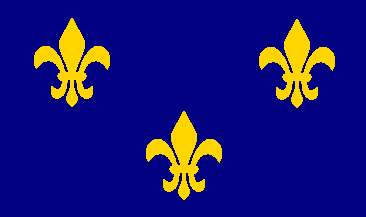

France Modern and France Ancient
- MOLINE CROSS
- In heraldry see cross moline.
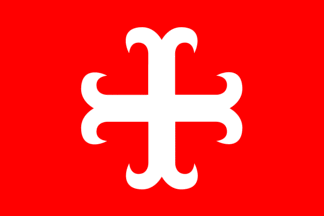
Flag of Chapelle-lez-Herlaimont, Belgium
- MON
- 1) Generically, the term used to describe a simple, often (but not exclusively)
circular design and the Japanese equivalent of a heraldic crest, badge or shield,
originally a personal or family symbol, they are now also common in Japanese civic and
provincial flags – but see 2) and the note below (also
daimyo flags and hinomaru).
2) Specifically, the term may be restricted to those Japanese flags showing a personal or
family badge – a kamon or mondokoro (see also imperial
standard 1) and imperial standard 2)).
![[Mon on Japanese flag]](../images/v/vx-jp-aogas.gif)
![[Mon on Japanese flag]](../images/v/vx-jp-40.gif)
![[Mon]](../images/v/vx-jp_rfnav.gif)
Flag of Aogashima Island, Japan; Flag of
Fukuoka, Japan; Standard of the
Imperial Family at Sea 1875–1889, Japan.
Please note with regard to 1) that the symbol on Japanese sub-national flags is
often a stylized version of the appropriate ideogram, and should be considered therefore,
the equivalent of a monogram or cipher rather than of a crest, badge or shield.
- MONDOKORO
-
- See mon 2)
![[mondokoro]](../images/v/vx-jp-r-ems.gif)
Standard of The Empress of Japan
- MONOCHROME (or MONOCHROMATIC)
- 1) The terms used when the illustration of a flag, or of a coat of arms, is
rendered in tones or shades of a single colour, often (but by no means
invariably) black/grey on white (see also hatching).
2) The terms also used when a flag uses only black and white in its design.
3) See monocolour.
![[Crikvenica - monocolour]](../images/v/vxt-d244b.gif)
![[Union flag]](../images/v/vxt-d3013.gif)
![[Trengganu]](../images/v/vxt-d244c.gif)
Flag of Crikvenica, Croatia shown in Monochrome (fotw & CS);
Union Flag in Monochrome (flikr); National Flag of
Trengganu, Malaysia
- MONOCOLOUR/MONOCOLOURED (or MONOCOLOR/MONOCOLORED)
- 1) The terms used when a flag is composed of a single colour – a unicolour or unicoloured
-
2) The terms also sometimes employed to describe the field of a flag which is largely (but not
entirely) plain – see plain 2).
![[Fujairah]](../images/v/vx-ae-fuj02.gif)
![[Kedah]](../images/v/vx-my-kd.gif)
National Flag of Fujairah (now part of the UAE);
Flag of Kedah, Malaysia
- MONOGRAM
- A motif formed by one or more letters, formerly often intertwined and now
more usually seen plain, as for example, on the royal standard of Belgium and
some presidential flags of France – a cipher or ligature (this last especially
if of only two letters) – but see royal cypher 1).
![[Monograms on flags]](../images/v/vx-fr_prgpo.gif)
![[Monograms on flags]](../images/v/vx-mc_aii.gif)
![[Monograms on flags]](../images/v/vx-be_roy.gif)
Presidential Flag of France 1969–74;
Princely Standard of Monaco;
Royal Standard of Belgium 1993–2013
- MOON
- 1) In vexillology see crescent 1) and
disc
(also waning or waxing moon).
- 2) In heraldry the term used for a crescent that is placed with its horns pointing upward – but
see notes below and crescent 2).


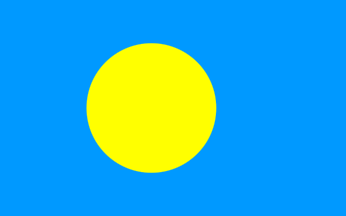
Flag of Čepin, Croatia;
Flag of Waltenheim, France (former version);
National Flag of Palau
Notes
a) With regard to 2), when a crescent moon is shown with its
horns towards the dexter it is termed increscent or increment, towards the sinister decrescent or
decrement, and towards the base inverted or reversed, when however, it is shown full (usually with a face) the term used is per complement.
b) A crescent with a face is occasionally seen in European heraldry, and it is not entirely unknown in
English heraldic practice – see figured.
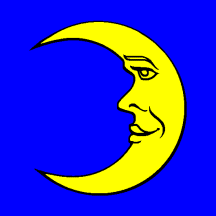
Flag of Boswil, Switzerland
- MORNING COLOURS (or COLORS)
- See colours 5).
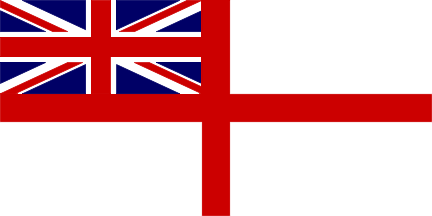

Naval Ensign, UK; Naval Ensign
South Africa 1952–1981
- MORSE CODE SIGNALLING WITH FLAGS
- 1) The current system of signalling with flags (or with the arms alone in the absence of
flags) using the Morse code, where if hand-held vertically (above the head) they signify
dots and if held horizontally (at shoulder level) dashes (see also
international code of signals,
semaphore and
wigwag).
- 2) A system, now obsolete, of signalling with a single flag using the Morse code, where
short waves signified dots and long waves dashes – signalling by flag waving (see also
semaphore and
wigwag).
Notes
a) It is contained in the current (2005) Edition of the International Code
of Signals, and 2) had reasonably widespread use in the field prior to radio, both
between artillery batteries and forward observers, and for communication between naval and
army units ashore.
b) The 1937 (British) Admiralty Manual of Seamanship
gave the Morse code flags as plain blue, or white with a blue horizontal stripe (against
light or dark backgrounds respectively), but that other variants are known to have
existed.
- MORTARED
- In heraldry see masoned.
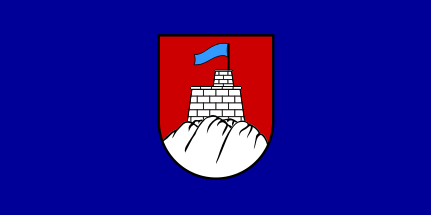
st-vg.gif)
Flag and Arms of Vrgorac, Croatia
- MOTTO
- A word or phrase, sometimes in a classical language, usually inscribed on
the scroll accompanying a coat of arms or state emblem, and originally derived
from the war cry (see also Appendix IV,
device 1) and scroll).

"Evil Be To Him Who Evil Thinks", The Motto of the Order of the Garter in Old French, UK
- MOUNT (MOUND or MOUNTAIN)
- The alternative heraldic terms for the base of a shield, banner of arms or a flag that forms a curve,
and is generally (but not exclusively) tinctured vert in order to represent a grassed hillock –
a mound or mountain – see compartment
(also coupeau, tincture
and vert).
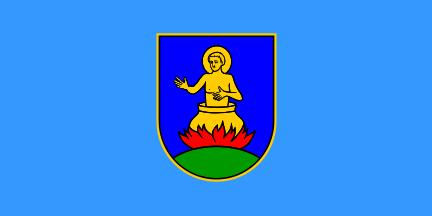
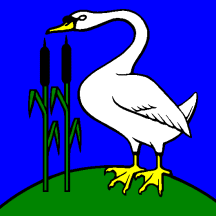
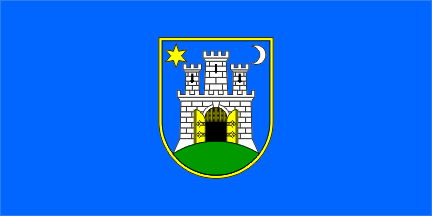
Flag of Brdovec, Croatia;
Flag of Merenschwand, Switzerland;
Flag of Zagreb, Croatia
- MOUNT OF COUPEAU (or COUPEAUX)
- In heraldry see coupeau (also mount above).
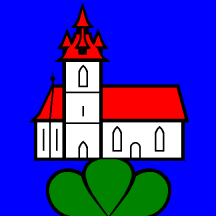
Flag of Kirchberg, Switzerland
- MOURNING BUNTING (or FAN)
- In US – particularly fire fighting – usage, a length of gathered decorative
fabric generally in black/purple (as a mourning version of the red-white-blue
national bunting), and draped between two anchor points to signify mourning for
the death of a colleague – see
bunting 2) (also
fan).

Please note that these colours are also seen in flag form.
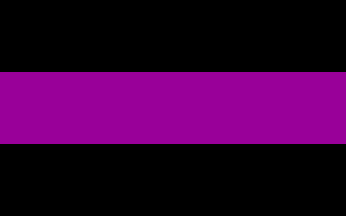
Mourning/Funeral Flag, US
- MOURNING FLAG
- An often (but not invariably) plain black flag of slightly varying design, displayed (sometimes
unofficially) by organisations and persons to signify mourning for people or events,
often (but not invariably) for political reasons – not to be confused with a
mourning pennant, pall
flag or funeral flag (see funeral flags,
mourning pennant below
and pall flag, also
cravat 2),
draping
and half mast a flag).

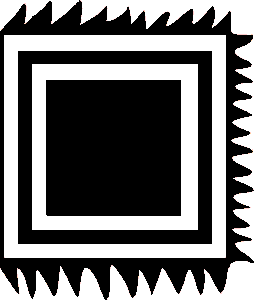
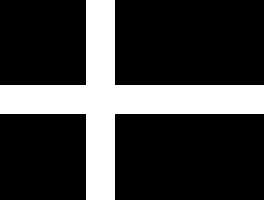
Mourning Flag: in widespread use;
Mourning Flag, Vietnam;
Mourning Flag, Denmark until 1743
- MOURNING PENNANT
- In Western European usage, a largely black triangular pennant of slightly varying design, flown from
the mainmast of vessels on inland waterways to signify mourning for the skipper or his spouse (see also
mourning flag above).

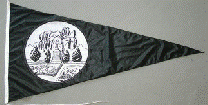
Catholic and Protestant Mourning Pennants (Litzke GmbH)
- MOURNING RIBBON (or MOURNING CRAVAT)
- See draping (also
cravat 2)).
![[draped flag]](../images/v/vx-dk_sgstf.gif)
National Flag of Denmark Draped with a Mourning Ribbon/Cravat
![[model flag example]](../images/v/vx-ca-yt.gif)
![[model flag example]](../images/v/vx-ng.gif)

![[Mon on Japanese flag]](../images/v/vx-jp-aogas.gif)
![[Mon on Japanese flag]](../images/v/vx-jp-40.gif)
![[Mon]](../images/v/vx-jp_rfnav.gif)
![[mondokoro]](../images/v/vx-jp-r-ems.gif)
![[Crikvenica - monocolour]](../images/v/vxt-d244b.gif)
![[Union flag]](../images/v/vxt-d3013.gif)
![[Trengganu]](../images/v/vxt-d244c.gif)
![[Fujairah]](../images/v/vx-ae-fuj02.gif)
![[Kedah]](../images/v/vx-my-kd.gif)
![[Monograms on flags]](../images/v/vx-fr_prgpo.gif)
![[Monograms on flags]](../images/v/vx-mc_aii.gif)
![[Monograms on flags]](../images/v/vx-be_roy.gif)







st-vg.gif)
![]()







![[draped flag]](../images/v/vx-dk_sgstf.gif)






